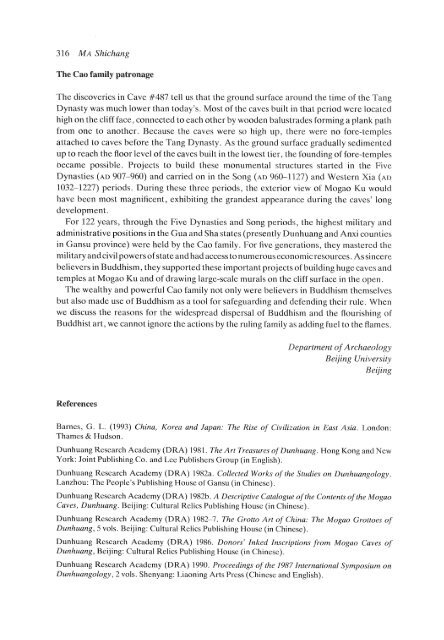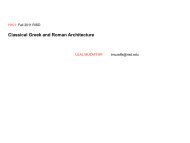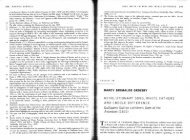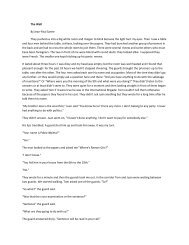Buddhist Cave-Temples and the Cao Family at Mogao Ku ...
Buddhist Cave-Temples and the Cao Family at Mogao Ku ...
Buddhist Cave-Temples and the Cao Family at Mogao Ku ...
You also want an ePaper? Increase the reach of your titles
YUMPU automatically turns print PDFs into web optimized ePapers that Google loves.
316 MA Shichang<br />
The <strong>Cao</strong> family p<strong>at</strong>ronage<br />
The discoveries in <strong>Cave</strong> #487 tell us th<strong>at</strong> <strong>the</strong> ground surface around <strong>the</strong> time of <strong>the</strong> Tang<br />
Dynasty was much lower than today's. Most of <strong>the</strong> caves built in th<strong>at</strong> period were loc<strong>at</strong>ed<br />
high on <strong>the</strong> cliff face, connected to each o<strong>the</strong>r by wooden balustrades forming a plank p<strong>at</strong>h<br />
from one to ano<strong>the</strong>r. Because <strong>the</strong> caves were so high up, <strong>the</strong>re were no fore-temples<br />
<strong>at</strong>tached to caves before <strong>the</strong> Tang Dynasty. As <strong>the</strong> ground surface gradually sedimented<br />
up to reach <strong>the</strong> floor level of <strong>the</strong> caves built in <strong>the</strong> lowest tier, <strong>the</strong> founding of fore-temples<br />
became possible. Projects to build <strong>the</strong>se monumental structures started in <strong>the</strong> Five<br />
Dynasties (AD 907-960) <strong>and</strong> carried on in <strong>the</strong> Song (AD 960-1127) <strong>and</strong> Western Xia (AD<br />
1032-1227) periods. During <strong>the</strong>se three periods, <strong>the</strong> exterior view of <strong>Mogao</strong> <strong>Ku</strong> would<br />
have been most magnificent, exhibiting <strong>the</strong> gr<strong>and</strong>est appearance during <strong>the</strong> caves' long<br />
development.<br />
For 122 years, through <strong>the</strong> Five Dynasties <strong>and</strong> Song periods, <strong>the</strong> highest military <strong>and</strong><br />
administr<strong>at</strong>ive positions in <strong>the</strong> Gua <strong>and</strong> Sha st<strong>at</strong>es (presently Dunhuang <strong>and</strong> Anxi counties<br />
in Gansu province) were held by <strong>the</strong> <strong>Cao</strong> family. For five gener<strong>at</strong>ions, <strong>the</strong>y mastered <strong>the</strong><br />
military <strong>and</strong> civil powers of st<strong>at</strong>e <strong>and</strong> had access to numerous economic resources. As sincere<br />
believers in Buddhism, <strong>the</strong>y supported <strong>the</strong>se important projects of building huge caves <strong>and</strong><br />
temples <strong>at</strong> <strong>Mogao</strong> <strong>Ku</strong> <strong>and</strong> of drawing large-scale murals on <strong>the</strong> cliff surface in <strong>the</strong> open.<br />
The wealthy <strong>and</strong> powerful <strong>Cao</strong> family not only were believers in Buddhism <strong>the</strong>mselves<br />
but also made use of Buddhism as a tool for safeguarding <strong>and</strong> defending <strong>the</strong>ir rule. When<br />
we discuss <strong>the</strong> reasons for <strong>the</strong> widespread dispersal of Buddhism <strong>and</strong> <strong>the</strong> flourishing of<br />
<strong>Buddhist</strong> art, we cannot ignore <strong>the</strong> actions by <strong>the</strong> ruling family as adding fuel to <strong>the</strong> flames.<br />
References<br />
Department of Archaeology<br />
Beijing University<br />
Beijing<br />
Barnes, G. L. (1993) China, Korea <strong>and</strong> Japan: The Rise of Civiliz<strong>at</strong>ion in East Asia. London:<br />
Thames & Hudson.<br />
Dunhuang Research Academy (DRA) 1981. The Art Treasures of Dunhuang. Hong Kong <strong>and</strong> New<br />
York: Joint Publishing Co. <strong>and</strong> Lee Publishers Group (in English).<br />
Dunhuang Research Academy (DRA) 1982a. Collected Works of <strong>the</strong> Studies on Dunhuangology.<br />
Lanzhou: The People's Publishing House of Gansu (in Chinese).<br />
Dunhuang Research Academy (DRA) 1982b. A Descriptive C<strong>at</strong>alogue of <strong>the</strong> Contents of <strong>the</strong> <strong>Mogao</strong><br />
<strong>Cave</strong>s, Dunhuang. Beijing: Cultural Relics Publishing House (in Chinese).<br />
Dunhuang Research Academy (DRA) 1982-7. The Grotto Art of China: The <strong>Mogao</strong> Grottoes of<br />
Dunhuang, 5 vols. Beijing: Cultural Relics Publishing House (in Chinese).<br />
Dunhuang Research Academy (DRA) 1986. Donors' Inked Inscriptions from <strong>Mogao</strong> <strong>Cave</strong>s of<br />
Dunhuang, Beijing: Cultural Relics Publishing House (in Chinese).<br />
Dunhuang Research Academy (DRA) 1990. Proceedings of <strong>the</strong> 1987 Intern<strong>at</strong>ional Symposium on<br />
Dunhuangology, 2 vols. Shenyang: Liaoning Arts Press (Chinese <strong>and</strong> English).





